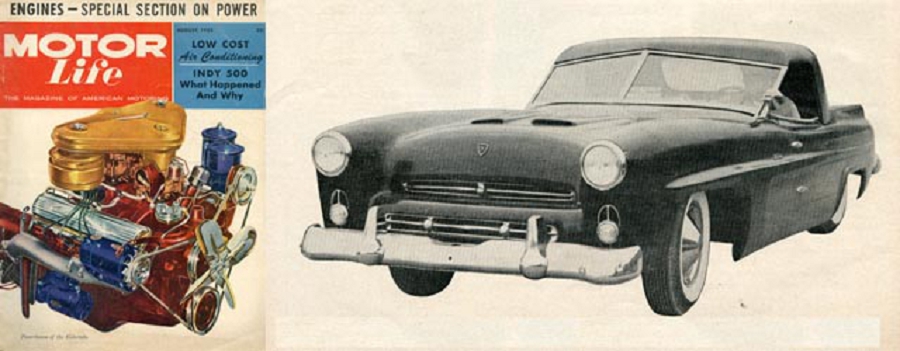
Hi Gang…
What fun it is to share the fiberglass designs of the Midwest. Recently, I wrote about the fiberglass cars of the Northeast in a story about the Rockefeller Yankee. Today’s story focuses on the Detroit born and bred La Saetta. This is one of a handful of cars designed and built in or near the Midwest which include:
- Chicagoan / Triplex / Ketcham (Illinois)
- Frazen (Ohio)
- Fibersport (Illinois)
- Frank Fisher Special (Illinois)
- Replac / Debonnaire (Ohio)
- And the Venus (Texas) and the Goff (Arkansas) – if you stretch the distance a bit
- And….we’re hoping one more Fibercraft sports car from Louisiana (we’re rooting for you Mel Keys!)
It’s interesting as you review styling of fiberglass cars in the early to mid ‘50s. As you go from West to East, the styling becomes, typically, more “Detroit-Like,” and that’s probably predictable and would occur for a variety of reasons. One reason would be to create a car more attuned to the Detroit buying public. Another might be just the lack of proximity of sports and race cars that would have been intensely in Southern California and not in the Midwest (but they would have been in some numbers in the Northeast..)
In any event, there is a difference as you make the progression from West to East. And with that, let’s have a look at a nicely designed sports car from Detroit, Michigan called the La Saetta – designed by Gino and Cesare Testaguzza.
Off we go…
La Saetta: The Thunderbolt
Motor Life, August 1955
By Ken Fermoyle
An Example, In Fiberglass, of the Italian Influence, Created in Detroit and Fashioned For Performance
Before you get confused, let us point out that you are looking at not one, but two different cars on these pages. Each, however, is a variation on the same theme – one of 15 cars produced thus far by the Testaguzza brothers in Detroit.
La Saetta (“The Thunderbolt” in Italian) is a long, low roadster of striking appearance and one that possesses many characteristics of the sports car. It is a dream come true for Cesare and Gino, the brothers, who were born in Italy, but came to the U.S. to work for Ford, Kaiser, Nash, Chrysler, and in styling aircraft before embarking upon the production of this particular vehicle.
The car is a genuine custom, normally built to a customer’s specifications, so generalizations on its details are difficult. The wheelbase runs about 110 inches, with overall length from 200 to 210. The price, complete, is in the $3500 bracket, with the fiberglass body alone available for around $1250. Choices in exterior colors, interior trim, instrument panels and accessories are practically unlimited.
When driven by a Motor Life staffer, times of less than 10 seconds in accelerating from zero to 60 mph were easy in a Hudson Hornet inline six-engined model. Top speeds of up to 110 mph were no strain.
Handling also was excellent and stepped-up steering permitted turns with less wheel movement. Since the car is built around a fiberglass body, it requires a rigid frame and chassis. The layout the Testaguzzas normally use has been a Ford frame cut down to proper size and beefed up.
A stock Ford rear axle and front suspension is used in most cases. And the car rides quite well, even at low speeds and over rough gravel roads. Extra bracing at key points for the detachable hardtop keeps rattles to a minimum.
So far, some 15 models have been built of the car and it would be hard to find two that are exactly alike. Big production is not planned, but many more models of the LaSaetta will be on the road in the near future.
Front Styling:
Flexibility in frontal treatment is apparent in the two photos below. Note variations with wrap-around and vee-type windshields. The latter probably will prove to be more popular since it can be had with a removable hardtop and, in fact, seems to be better looking.
Height at the cowl is only a little over three feet, which makes the car, even with the detachable hardtop, one you practically, can kneel alongside and still see over. One car has been fitted with air scoops on its hood.
Custom Built To Order:
Two different La Saettas received distinctly different instrument panels. The one at the extreme left is the latest style and is considered the better of the two. Also seen is the full bench seat, which is not favored over the bucket-type that permits lower and more secure seating.
Visibility, of course, is superb. In general, however, details of the cars vary considerably, since the vehicles are custom built to order and to suit personal taste.
Rear Styling:
Rear end views show contrasting themes in simple deck lid and one equipped with continental tire mount. Variety in lights also serves to make each car distinctive. Most of the models have been built on a Ford chassis and are powered by the Olds 88 engine.
However, the car shown here without the hardtop has the Hudson inline engine and has performed remarkably well. Ride is soft and there is a slight lean in hard turns, but overall handling qualities surpass most of the current production automobiles.
Summary:
Approximately 8 La Saettas have been sighted in recent years – one most recently in an auction in California. We’re still searching for one that has been restored, and as soon as we find one we’ll share it here at Forgotten Fiberglass 🙂
Hope you enjoyed the story, and until next time…
Glass on gang…
Geoff

——————————————————————-
Click on the Images Below to View Larger Pictures
——————————————————————-

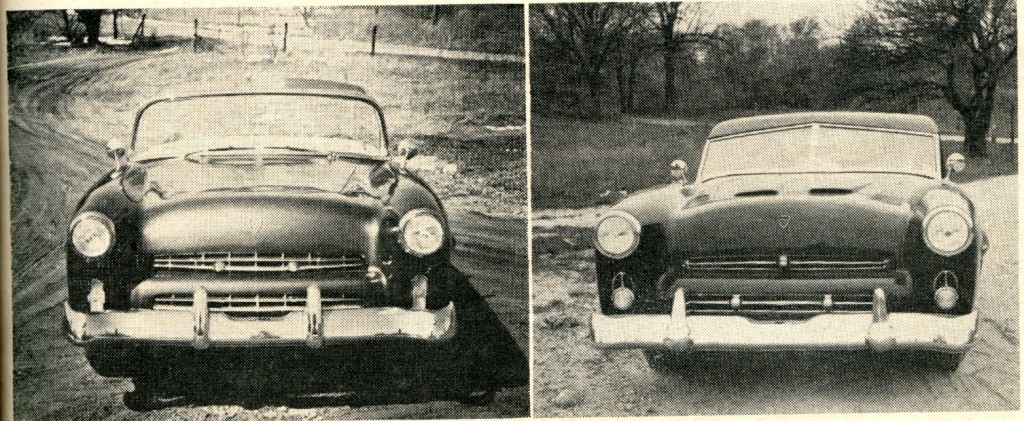

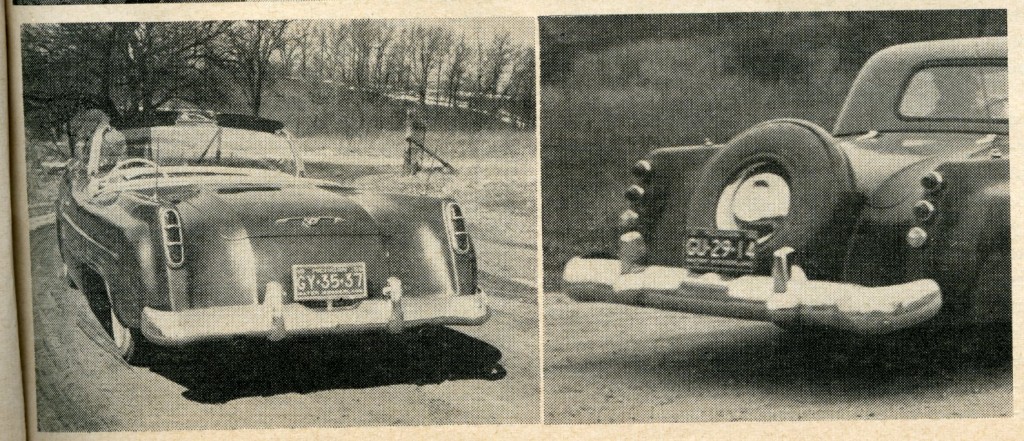



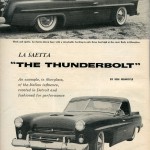
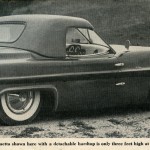
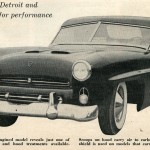

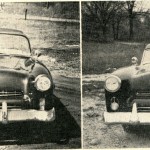
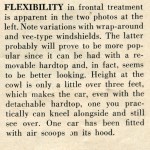
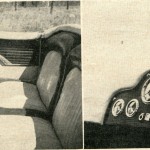
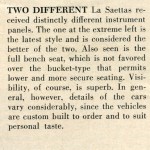
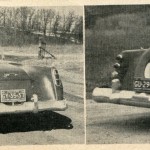
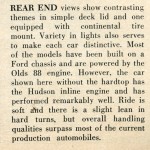
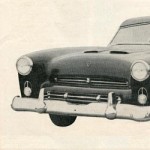
Hi Geoffrey,
I;m the guy who wrote the article on La Saetta featured on your FF site! Wow, it was strange seeing a piece I wrote all those years ago when I was Detroit Editor for Motor Life Magazine. I was a native Detroiter who was involved in one way or another with the auto industry for 30 years, 1947-1977. For a long time I was the only reporter on the auto beat who had ever actually worked in an auto plant (Chrysler Highland Park & the old Dodge Main in Hamtramck). I began my journalism career in October, 1947 when I was a college freshman on the GI Bill on The Wage Earner, a labor paper that concentrated on the car industry.
I was a reporter on Ford’s Rouge News employee paper in 1951 & promoted to publiscations editor at the then-new Ford Research & Engineering Center in 1952–the same year I began free-lancing for car magazines. I joined Motor Life in 1955 & went to Popular Science in 1959, spent some time in advertising (on auto accounts) in the 1960s, then rejoined Petersen Publications as editor of Wheels Afield in 1966 for 10 years. I worked at SCORE & freelanced after Petersen killed Wheels Afield during the ’70s oil embargo.
I’m 87 now, but still at it. I write for a few publications, mostly local, and had a book — “Vietnam Labyrinth: Allies, Enemies & Why the U.S. :Lost the War” — published last year. Also do a lot of photography & for the past 15 years have been creating digital art, thus my Grandpa Moses nickname.
But I’m running on far too long. It’s just that seeing the Thunderbolt article, written nearly 60 years ago, brought back a LOT of fond memories.
Take care, Ken
—
Ken Fermoyle
aka “Grandpa Moses of the Cyber Age”
writer, author, photographer, digital artist
Woodland Hills, CA
Hi, thanks for the write up, Geoff. Gino is actually my grandfather so I’ve been googling some stuff about his work. While he is greatly missed, it’s nice to see how his work continues to live on.
The tucson car is long gone ,the man who ran Obars salvage was a certified nut .Sorry but i had heard his story about the jag engine too many times, He was know to say anything to make a sell, By the way the car was a true glass bucket. cracked and torn glass it wolud have taken a true master glass man to save that one.
I could have fixed it, I learned the fiberglas business from the Testaguzza
brothers in the 60’s and worked on many sculpture projects with them.
I went on to owning the largest production fabrication business in the
state of Nevada.
Still hoping someone with serious intent pulled the La Saetta out of the north Tucson, AZ, truck salvage and will bring its updated status to our attention. It was on an XK Jaguar chassis and while the motor was missing when I photographed it, was supposed to be known and available “in town”.
The interior photograph showing the bench seat shows classic ’55 – ’57 Thunderbird styled upholstery.